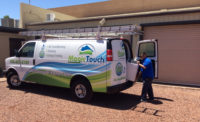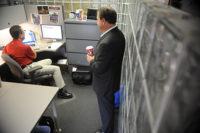When a customer calls with an urgent need for cooling, portable air conditioners are often the fastest way to restore cooling. There are many options for renting portable coolers, but in a pinch, how can contractors guarantee they’ll get what customers need? Here are some guidelines to ensure a company rents the right portable equipment and some tips for speeding up the response time.
SITE SPECS
According to Jon Fox, project manager of Metropolitan Mechanical Contractors in Eden Prairie, Minnesota, there are three basic things contractors need to know to rent the right portable units for their customers.
“You have to know the space available for the units, the capacity needed, and the electrical source available,” Fox said.
While these are the most important details to know about the site, the more information the contractor knows and can pass on to the rental company, the better.
“We recommend you contact us prepared with several important pieces of information that are necessary for our team to determine the most appropriate equipment for your particular application,” said Amanda Rahn, marketing manager at Temp-Air. Specifically, Rahn said, the team at Temp-Air needs to know the following information to prepare a quote: the project room dimensions, whether the space is open or partitioned, the number of floors at the facility, the desired interior temperature, the type of fuel available, and the type of power available.
Tina Behnke, who handles business development for AirPac Inc., said her company hands out plastic, wallet-sized cards with a 10-question checklist to help remind contractors of the information they need to collect from customers. (See the sidebar at right for the complete checklist.)
Above all, Behnke stressed that the most important piece of information to pass along to the rental company is the power available at the site.
“Portable air conditioners come in different cooling capacities and voltages,” Behnke explained. “If a unit is delivered on-site and the contractor doesn’t have the power needed to operate it, then nothing else matters.”
To make sure installers have the right information about a site’s available power, Scott Brainard, Temp-Air vice president of product development, recommends contractors connect with facility staff.
“Power availability — voltage and available amps — is critical to know before units can be recommended,” Brainard said. “Having a facility manager or engineer involved will help answer these types of questions.”
Not only does being knowledgeable about a customer’s site aid contractors in getting the right equipment for the job, it can also speed up the response time from the rental company.
According to Brandon Corr, project manager for Gilbert Mechanical in Minneapolis: “Your sales reps have a large variety of equipment at their disposal, but they need information to help you pick the best equipment for your application.
“If you can tell your sales rep roughly the cooling load you have and the details of the install, then they can quickly select the best piece of equipment for you,” he continued. “The location of the portable cooler is another important detail.”
Rahn also emphasized that the location of the portable units is a significant factor in equipment selection.
“Determining the location where the units will stay throughout the duration of the project greatly influences equipment choice. If a unit will be cooling a small amount of square footage, a compact air conditioner on casters may be pushed from room to room through a standard 36-inch-wide door,” she said. “If a larger space is to be cooled, units without wheels may be trailered to an exterior location, and ducting would be used to send cool air inside the building through windows or other openings.”
BUILDING RELATIONSHIPS
After determining which type of portable units are needed, the next step is getting them on-site as quickly as possible. To get a quick response, both Corr and Fox believe it’s beneficial for contractors to build relationships with rental suppliers.
“I tend to establish a strong relationship with one supplier,” Corr said. “When everyone gets busy, it helps to have a strong relationship with a supplier that will help you out when you’re in a bind.”Fox also said his approach has been to establish a strong relationship with one rental company. While other project managers at MMC use a variety of rental companies, Fox relies solely on Temp-Air.
He said his relationship with Temp-Air has been strengthened through great customer service.
“They’re always there when I need them,” Fox said, adding his personal rep is always quick to respond to calls or emails. “There is a 24/7 service line, but I’ve never had to use it.”
When you’re dealing with a customer in the middle of an emergency, the importance of a good relationship is apparent in response times.
“I’ve seen as fast as a two-hour turnaround in an emergency situation,” Fox said.
Behnke said it’s best to establish a relationship before rental services are needed.
“When there’s an emergency and things need to happen quickly, we can be of most value when we have all the logistics taken care of — the billing, points of contact, etc.,” she said. “Then we can focus on solving the air conditioning emergency and getting clients the cooling they need.”
Plus, Behnke said, “If we have a relationship established with the contractor, we often have the truck loaded and our driver on the way before all the details are finalized.”
By building a solid relationship with a supplier and learning the ins and outs of renting portable coolers, contractors can be better prepared to quickly meet customers’ needs.
SIDEBAR: TOP 10 CHECKLIST FOR PORTABLE RENTALS
According to AirPac Inc., these are the 10 most important things contractors should know before they call to rent portable air conditioners.
1. What is the physical size of the space to be cooled?
2. What is the cooling capacity of the a/c system that failed?
3. How much cooling must you have for emergency cooling?
4. What power (115, 208/1, 208/3, 460/3) is available at the facility?
5. How much space is available for units, and will they sit inside the space you need to cool or outside the space?
6. How will supply air (the cold air) be distributed? Do you want to duct the air or will it blow freely from the a/c unit?
7. Where will condenser air (the warm air) be discharged?
8. How will the condensate be removed? Will you manually empty the tanks, or can you use the condensate pump?
9. When are units needed?
10. How long are units needed?
Publication date: 6/27/2016
Want more HVAC industry news and information? Join The NEWS on Facebook, Twitter, and LinkedIn today!







